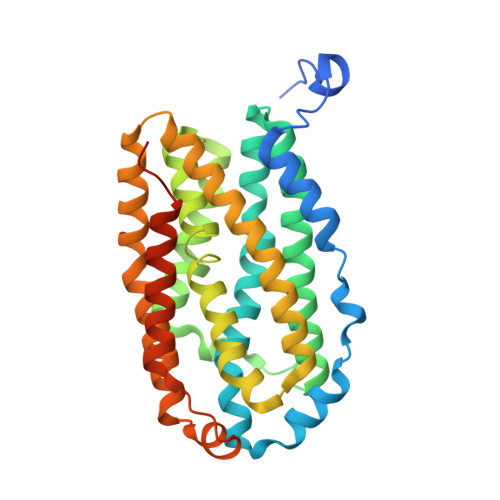Divergent assembly mechanisms of the manganese/iron cofactors in R2lox and R2c proteins.
Kutin, Y., Srinivas, V., Fritz, M., Kositzki, R., Shafaat, H.S., Birrell, J., Bill, E., Haumann, M., Lubitz, W., Hogbom, M., Griese, J.J., Cox, N.(2016) J Inorg Biochem 162: 164-177
- PubMed: 27138102
- DOI: https://doi.org/10.1016/j.jinorgbio.2016.04.019
- Primary Citation of Related Structures:
5EKB - PubMed Abstract:
A manganese/iron cofactor which performs multi-electron oxidative chemistry is found in two classes of ferritin-like proteins, the small subunit (R2) of class Ic ribonucleotide reductase (R2c) and the R2-like ligand-binding oxidase (R2lox). It is unclear how a heterodimeric Mn/Fe metallocofactor is assembled in these two related proteins as opposed to a homodimeric Fe/Fe cofactor, especially considering the structural similarity and proximity of the two metal-binding sites in both protein scaffolds and the similar first coordination sphere ligand preferences of Mn II and Fe II . Using EPR and Mössbauer spectroscopies as well as X-ray anomalous dispersion, we examined metal loading and cofactor activation of both proteins in vitro (in solution). We find divergent cofactor assembly mechanisms for the two systems. In both cases, excess Mn II promotes heterobimetallic cofactor assembly. In the absence of Fe II , R2c cooperatively binds Mn II at both metal sites, whereas R2lox does not readily bind Mn II at either site. Heterometallic cofactor assembly is favored at substoichiometric Fe II concentrations in R2lox. Fe II and Mn II likely bind to the protein in a stepwise fashion, with Fe II binding to site 2 initiating cofactor assembly. In R2c, however, heterometallic assembly is presumably achieved by the displacement of Mn II by Fe II at site 2. The divergent metal loading mechanisms are correlated with the putative in vivo functions of R2c and R2lox, and most likely with the intracellular Mn II /Fe II concentrations in the host organisms from which they were isolated.
- Max Planck Institute for Chemical Energy Conversion, Stiftstr. 34-36, D-45470 Mülheim an der Ruhr, Germany.
Organizational Affiliation:



















